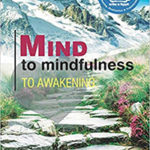The best way to learn mindfulness is to learn from our experiences daily. As long as we are alive, we have experienced it. All experiences happen in the mind. These experiences are related to the body, breath, mind, intellect, ego, and something beyond them. These experiences are and not limited to sensations, feelings, emotions, thoughts that further translates into positives and negatives, high and low, good and bad. They are all about the mind.
ShreyasvsPreyas (good vs. likes/dislikes) – two ways of the leading life
अन्यच्छ्रेयोऽन्यदुतैवप्रेयस्तेउभेनानार्थेपुरुषँसिनीतः ।
तयोःश्रेयआददानस्यसाधुर्भवतिहीयतेऽर्थाद्य उ प्रेयोवृणीते ॥
Katho Upanishad 1.2.1 ॥
anyacchreyo’nyadutaivapreyasteubhenānārthepuruṣam̐ sinītaḥ |
tayoḥśreyaādadānasyasādhurbhavatihīyate’rthādya u preyovṛṇīte ||
One is good while another is pleasant. These two, serving different ends, bind men; happiness comes to him, who, of these, chooses the good; whoso chooses the pleasant forfeits the true end.
There are two ways of living life- day to day and moment to moment. Preyas is what gives pleasure when connected or related to people, place, possession, time, and events. Shreyas is what is good, permanent, devoid of dualities caused by the mind. It is peace, happiness, love, wisdom, truth, and independence from people, place, possession, and time.
Preyas is pleasant and short-lived, hence the mind craves for it, gives constant trigger to the mind within. Preyas is the source of all pleasures, pains, stress, and suffering. Preyas gives temporary happiness that turns into sorrow. People marry for happiness and divorce for happiness. People remarry for happiness and do not think rightly. This is an example of the movement of Preyas in life. Preyas leads to attraction, pleasure, cravings, addiction, and miseries in life. It is like a fish, tempted, and get caught by a fish catcher. A deer is caught by the sound of the flute. The he-elephant is lured by the sense of touch of she-elephant, used by hunters to catch them.
A weak mind is an impure mind. An impure mind is lured by people, place, possession, and time. This mind is absorbed by pleasure, hyperactivity, lethargies, reactions, anger, and agitations. Masters say that an impure mind leads to three vices -sensual pleasures, anger, and greed. When the mind lives in three vices, the kundalini is sleeping in lower chakras and continues to create suffering in life. Preyas means the mind is constantly seeking pleasure, escaping pain, and then find itself caught in the web od likes, dislikes, pain, and pleasure.
Shreyas is the way of living life based on what is good. It may seem unattractive to people in the beginning. But what is unattractive is caused by the impure mind. The impure mind is the default setting of mind. We are evolving constantly, the mind must think, contemplate, and reflect on what is good, better, and the best for life and for all at the same time. This is exactly the path Shreyas. Shreyas discovers our true nature – the everlasting peace, happiness, love, and wisdom. Then we live and express the same peace, happiness, love, and wisdom in personal, professional, social, and family lives. Shreyas is a way to take over the mind that is craving by what is good for one and all.
Masters for the last 6000 years guide through principles of eastern wisdom – what is good in life. Master disciple tradition is required the way it is required to become a doctor or engineer. Googling mindfulness seldom works, except giving some relaxation. How to move consciously from Preyas to Shreyas starts in three steps learning the principles from the master, contemplation, and reflection to clear the mind from impurities and regular practice with wisdom.
Put all experiences to test if they are good or entered life because of likes and dislikes. Anything that enters life with likes and dislikes of the mind may lead to suffering. The word Shreyas means what is good for me. Our attitudes, behavior, thought patterns, feelings, and sensations.



